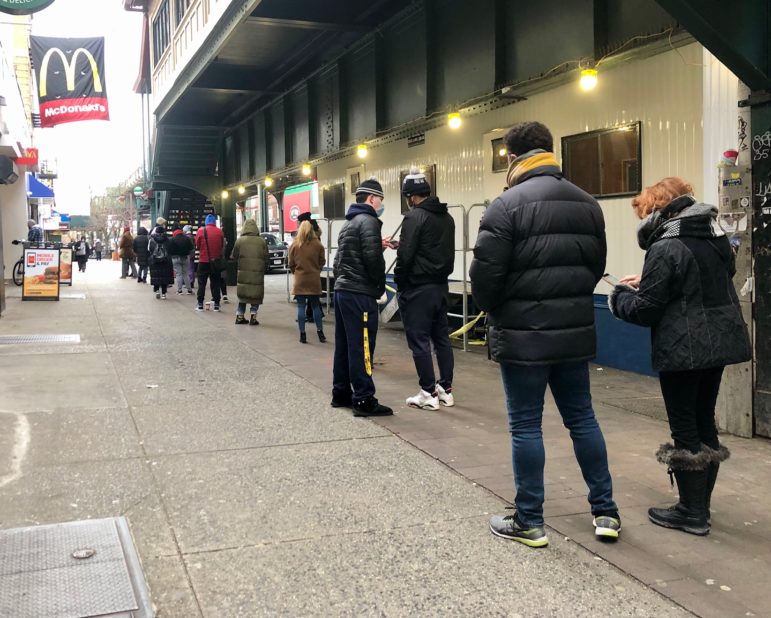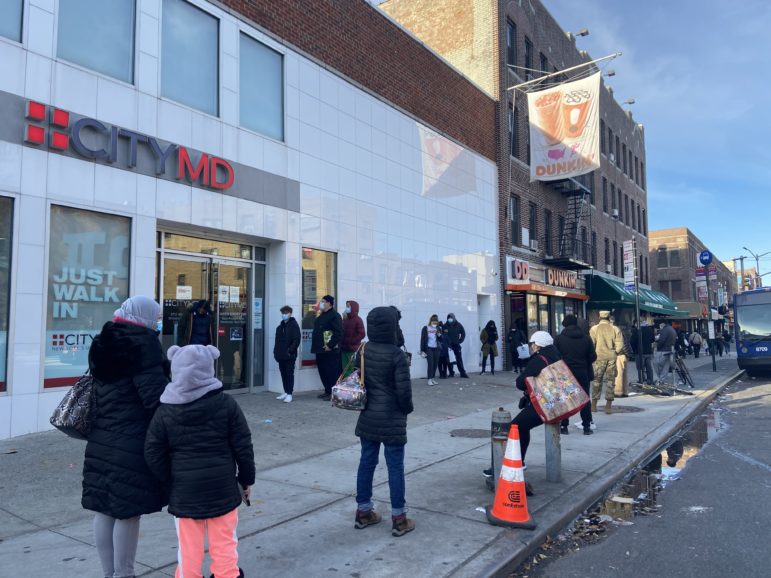It’s not clear yet if the December holidays will draw same test-line crowds that Thanksgiving did: An average of 48,380 New Yorkers got molecular coronavirus tests on Dec. 14, the most recent date for which city data is available, well below the high of 58,243 people who were tested on Nov. 24.
and Gun Hill Road in the Bronx, from 2:35 to 3:35 p.m. on Dec. 11. // Adi Talwar
At around 3 p.m. on Monday, the streets of City Island were quiet and the sidewalks all but empty—except for the stretch of City Island Avenue near Hawkins Street. On a summer afternoon, that block might be lined with people waiting to get a cone or cup from Lickety Split, an ice cream stand and City Island institution. But this week the line of 25 people, waiting in the cold rain, was for COVID testing. The tent and van that had pulled up alongside Hawkins Park was part of a testing spree on the island that began the previous week and stretched over the weekend, following a spike in cases there that briefly sent the neighborhood’s positivity rate to over 10 percent, one of the highest in the city.
“A lot of people don’t wear masks around here and they got together and they got sick,” was Dan Trieber’s matter-of-fact take on Friday. He’s a City Island lifer who operates a vintage toy store out of his childhood home on City Island Avenue; it’s where the island’s community fridge is (and will remain, Trieber vows, even if some neighbor did call in a complaint to the city about it being contrary to code). “Everybody got together for Thanksgiving,” he said.
As infection rates rise citywide, New Yorkers are lining up in the cold for coronavirus tests, some for hours at a time. Some of these scenes are reminiscent of last month, when residents rushed to get tests ahead of Thanksgiving, prompting the city to open more than two dozen new testing locations and begin posting wait times online. It’s not clear yet if the December holidays will draw quite the same level of test-line crowds: An average of 48,380 New Yorkers got molecular coronavirus tests on Dec. 14, the most recent date for which city data is available, well below the high of 58,243 people who were tested on Nov. 24.

Jeanmarie Evelly
The line at the CityMD location on 31st Street in Astoria around noon on Dec. 16.City Limits visited several testing sites this week and found some locations with hours-long waits, while others had modest or barely-there crowds. In the Bronx’s Norwood neighborhood at 1 p.m. on Tuesday, four people stood outside the door to the testing area at North Central Bronx Hospital. Some of the dozen or so people spaced around the lobby appeared to be waiting for testing, too. Among those in line was Andre, who was waiting to get tested for his fourth time. The first was in April when a colleague at work tested positive. That last time was in late August or early September, when he wanted to get cleared to travel to his native Jamaica. Now, he’s planning a trip there again, to celebrate his birthday.
Is he worried about having COVID-19? No, he says. But he’s quick to add, “I’m not saying I’m going to be careless. I’m just not really worried.” That’s true as well for traveling on a plane, as he will soon do. “It’s all in how you carry yourself,” he says. He shows off the sanitizer he carries, and says he brings disinfecting wipes on the planes as well. “To each their own.”
Over in Wakefield, there was barely a line at 4101 White Plains Road, the offices of Community Board 12. The board’s offices are closed, but down a side street is the entrance to the testing center. The worker at the door made sure to keep the number of people in the lobby to a minimum, so one of two people waited outside for a few moments, but their turn came soon.
Outside the RAIN Senior Center on Boston Road down in Allerton, there were lines of white paint all the way up the concrete ramp to the door where a stand of hand sanitizer and a cheery oak-tag sign announced the COVID testing facility. But no one was on the ramp, or even inside the waiting room inside the door.
A worker who came out for a smoke break put her Newport back in its box and headed back to the door when she thought she saw a new patient coming. She told City Limits that it was not normally quite so crowded; it had been crowded that morning. But crowded enough that people would be lined up down to the sidewalk? “No,” she said. “Never.”
In Queens and Brooklyn, several CityMD locations—which offer free COVID tests through a partnership with the city—drew larger crowds this week, including the clinic on 87th Street and 4th Avenue in Bay Ridge, where nearly two dozen people waited in line around 2 p.m. Tuesday.
A similar number of people were lined up around noon the next day at the CityMD on 31st Street and Ditmars Boulevard in Astoria, some of them hopping up and down to stay warm in the cold. Among them was Alena Clavijo, who said she’d been waiting for two hours so far. The line had been long all day, and she’d come expecting a wait based on her previous experiences getting tested in the city.
“It’s always a long line,” said the Astoria resident.
Another CityMD location in the neighborhood, at 31-11 Steinway St., had a different system in place, signing up those who arrived and assigning them a specific time to come back that day and get tested. By around 3 p.m. Tuesday, all of the day’s testing slots had already been filled. A staffer advised people to come back early the next day—around 7 a.m., if possible—to secure a spot. On Wednesday, all of the appointments were once again filled by the time a City Limits reporter called to inquire, around 11:30 a.m.
“There is definitely an increase,” one staffer at the site said, saying the location was testing an average of 400 patients per day.

Nicole Javorsky
The line at the Bay Ridge CityMD clinic around 2 p.m. on Dec. 15.On Friday, wait times at the city’s Health + Hospitals testing sites were similarly hit or miss: The testing site at the Highbridge Pool was reporting a more than two-hour wait as of 2 p.m., 11 other sites were reporting lines of at least an hour and five other sites reported no wait at all.
City officials continue to encourage New Yorkers to get tested frequently as part of its efforts to contain the spread of the virus. The city reported 2,805 new confirmed and probable COVID-19 cases on Friday, a number Mayor Bill de Blasio described as “through the roof,” while the 7-day positivity rate was just over 6 percent, which he called “way too high.”
“We all are dealing with a real challenge, as our indicators make clear, and we all need to focus on wearing masks, on social distancing, avoiding gatherings, not having big family gatherings, not traveling—all of this matters,” he said.
With reporting by Jarrett Murphy, Nicole Javorsky, Daniel Parra and Jeanmarie Evelly








